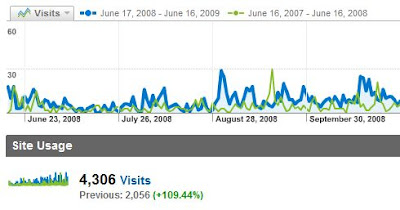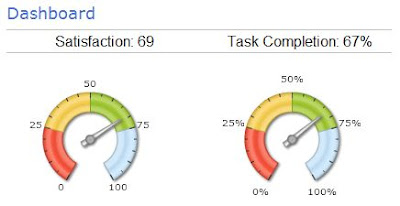Things around analytis are really heating up in Finland and I know that it has tested my family's patience a lot. But no worries my ladies, daddy is having 5 weeks' summer vacation coming up. It's really hard to conclude all the benefits from blogging. So this is quite long post, just try to hang on. You may got an idea or two. A year ago I set up some goals, now it's time to look if they were accomplished or not:
- One post per week. Didn't happen. Actually I posted exactly same amount of posts, 30, than during first year. So I was 42 % behing my goal. But I stongly believe that my raw author data (amount of words) grew a lot. Please email me if you know an easy way to calculate raw author data.
- Increase visits more than 100 %. Completed. Visits to my blog increased +109 %. There were visitors from 80 countries (41 last year), 4.306 visits and 3.012 visitors total, average 12 visits per day.

- One comment per post (excluding mine). Almost there. There was 27 reader comments, so 90 % of goal achieved. Multichannel measurement and IMC presentation posts collected most, 5 comments each.
- One hundred subscribers. Well, not quite. As you can see at the moment my blog is having 80 subscribers.

- Public speaking gigs (billable and non-billable). Yes indeed. I had couple of billable speaking gigs and the rest were for marketing. We are not talking about thousands of euros...yet, but it's a good start because sometimes you have to pay for a speaking lot.
I was speaking about search engine marketing and measuring in a e-commerce seminar for a group of people and in a Chamber of Commerce event with 135 people. You can download my SEM presentation (in Finnish, pdf file 18 MB).
I was also speaking at Internet Marketing Concerence in Stockholm about multichannel measurement and marketing optimization. Check out case SeaLife presentation. I also had a chance to represent some web analytics for Board Professional ladies and I introduced search engine marketing in a business date kind of event.
Last year my eMetrics presentation was cancelled, but this year I believe that I will get on stage at eMetrics Stockholm. WAA Finland got some visibility in media and as we speak, we are planning to have a huge, international and FREE event around multi-/cross-channel mesurement during September. If things goes well and as planned, this will be defenitely the best event for marketing and any C-level people in Helsinki during this fall.
WAA Finland arranged already two Web Analytics Wednesdays this year with almost a hundred participants each. And by the way, I had also couple of interviews for a few newspapers. You can download one short article here (in Finnish, pdf).
Analyzing visits, sources and content
Regarding to visits and content of my blog, here's an example picture on how to use standard deviation for figuring out what is a clear peak or not normal.

With this graph you can easily connect three last visit peaks over standard deviation maximum limit to following posts:
How next generation uses Internet - an interview
Recap of Internet Marketing Conference in Stockholm
Recap of Web Analytics Wednesday in Helsinki
During first year there was four posts which gathered more than 25 visits per day. Last year there has been 14 posts with over 30 visits per day. With Feedburner feed item statistics you can confirm what content has been most popular. I like most my April fool's day joke post.

After a title change of my blog I have received a lot more visits from search engines. And "brand", that means my name, related keywords had a share of 22 % of all keywords used. Google rules because it's share is 96,5 % of all search engine traffic to this blog.
 Social media
Social mediaDuring the last year the use of social media has grown a lot. I have used these powerful platforms and I see this in traffic sources where social media references are increasing. In Facebook my blog has 47 followers and in Twitter 81. I have been twittering since first of April and just now I'm getting how companies can benefit from Twitter.
Little development
During the last year my blog has been also a play ground where to test different kind of things.
Couple weeks ago I installed the new Yahoo! web analytics 9.5 version. As I have been always in business-to-business mode, I really like this last visitor details report of Yahoo! And they now have extra demographic features in like age and gender.

In order to get more visitors and social media effect, I have added the share button in the end of each post. I also use Google Webmaster tools for analyzing search engine visibility and technical optimization issues as well.
Getting some feedback
I'm not satisfied how people are reacting and commenting my writings. If you read this, please send me feedback by email, leave a comment or push the feedback button on the right. With free 4Q or Kampyle tool you can easily collect the voice of customer, as you can see from these dashboards. Of course, I would like to get the overall satisfaction and task completion rate little higher.

 Goals for the next year
Goals for the next yearDuring the summer I will be a guest-writer to Vierityspalkki and blog of Lars. And finally, here are my public goals for the next year:
- No more posting goals. This is a kind of hobby for me and this should be fun. I will continue posting, that's for sure, but you can expect the same frequency as so far.
- Double the amount of visits
- Two reader comments per post
- Two hundred subscriptions
- Speaking gigs plus more visibility in media
It's really hard to sum up all the benefits and experiences, but when I look at why I decided to blog in the first place, I find some of these reasons are still valid. I want to share information and it's helping us with consulting and sales. I would like to keep this forum relaxed although writing about serious business.
I think blogging is very therapeutic stuff and is highly recommended. However, you need to find your own niche to write about and and you have to be persistant. Write about something you're very interested in and you'll find your motivation. One thing is sure: Petri Mertanen brand is in rise... : )
